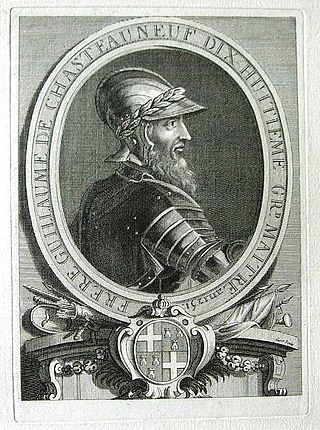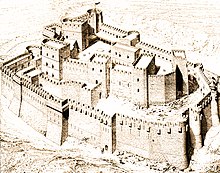
Blessed Gerard Sasso, known also as Gérard de Martigues, was a lay brother in the Benedictine Order who was appointed as rector of the hospice in Jerusalem at Muristan in 1080. In the wake of the success of the First Crusade in 1099, he became the founder of the Order of St John of Jerusalem, also known as the Knights Hospitaller, an organization that received papal recognition in 1113. As such, he was the first Grand Master of the Knights Hospitaller.

Jobert of Syria was the seventh Grand Master of the Knights Hospitaller, in Syria from 1172 to his death, which is thought to have occurred in 1177. He was succeeded by Roger de Moulins.

Guérin de Montaigu, also known as Garin de Montaigu or Pierre Guérin de Montaigu, was a nobleman from Auvergne, who became the fourteenth Grand Master of the Knights Hospitaller, serving from 1207–1228. He succeeded the Grand Master Geoffroy le Rat after his death in 1206, and was succeeded by Bertrand de Thessy.
Gilbert of Assailly was the fifth master of the Knights Hospitaller, serving from 1162 or 1163 to 1170, when he was deposed. As Grand Master, he succeeded Auger de Balben. Nevertheless, most sources list him as the fifth, rather than fourth, master and this biography continues that tradition, with the exception being Delaville Le Roulx' work. He was succeeded by Gastone de Murols. Gilbert encouraged Amalric of Jerusalem in his unsuccessful invasion of Egypt, leaving the Order in debt and causing the reexamination of its military role.

Odo de Pins, also known as Eudes de Pin or Odon de Pins, was the twenty-third Grand Master of the Knights Hospitaller, serving from 1294 until his death in 1296, succeeding Jean de Villiers. He moved the headquarters of the Order to Limasso in modern-day Cyprus. Upon his death, he was succeeded by Guillaume de Villaret.

Jean de Villiers was the twenty-second grand master of the Knights Hospitaller, serving from 1285 until 1293. He was elected Grand Master after the death of Nicolas Lorgne. De Villiers was Prior of France beginning in 1282 and he remained in France to deal with existing problems of the Order. Jacques de Taxi became Grand Master ad interim, perhaps through 27 June 1286, while awaiting the arrival of the newly elected Grand Master in the Holy Land. De Villiers was present at the Siege of Acre in 1291, but escaped just before the city fell to the Mamluks. He was succeeded by Odon de Pins.

Garnier de Nablus, also known as Garnier of Syria, was the tenth Grand Master of the Knights Hospitaller from 1190 to 1192, succeeding Armengol de Aspa. He fought at the Battle of Arsuf in 1191 during the Third Crusade. It was under his magistracy that the headquarters of the Order were transferred from Tyre to Acre. He was succeeded by Geoffroy de Donjon.
Hugues de Revel was an English knight who became the twentieth grand master of the Knights Hospitaller, serving from 1258 to 1277 as the successor to Guillaume de Chateauneuf. He was succeeded by Nicolas Lorgne.

Geoffroy de Donjon, also known as or Geoffroy de Duisson, was the eleventhth Grand Master of the Knights Hospitaller serving from 1193 through his death in 1202. He succeeded Garnier de Nablus who died in August 1192.
Pierre de Mirmande was a French nobleman of the Order of Saint-John of Jerusalem from the end of the 12th century to the beginning of the 13th century. He served as interim Grand Master of the Knights Hospitaller after the death of Geoffroy de Donjon in 1202. He was replaced by Fernando Afonso of Portugal who became Grand Master in 1202.

Pierre de Vieille-Brioude, or Vieille-Bride, was a nobleman from Auvergne who was the eighteenth Grand Master of the Knights Hospitaller between 1240 and 1242, succeeding Bertrand de Comps. He was succeeded by Guillaume de Chateauneuf.

Guillaume de Chateauneuf was the nineteenth Grand Master of the Knights Hospitaller, serving first from 1242–1244 as the successor to Pierre de Vieille-Brioude. He was captured during the Battle of La Forbie in 1244, held hostage in Egypt and ransomed through the Sixth Crusade. During his captivity, his position was filled on an interim basis by Jean de Ronay. De Ronay died in 1250, and de Chateauneuf was released shortly thereafter. He was succeeded by Hugues de Revel.

Bertrand de Thessy, also known as Bertrand of Thercy, was the fifteenth Grand Master of the Knights Hospitaller, serving between 1228 and 1230 or 1231. He succeeded Guérin de Montaigu upon his death on 1 March 1228. Thessy was either from France or Italy, most likely the former. He was succeeded by Guérin Lebrun.

Guérin Lebrun was the sixteenth Grand Master of the Knights Hospitaller, serving between 1228 and 1231. He succeeded Bertrand de Thessy in 1230 or 1231. As he was Prior of France, he was likely from France and is generally referred to by the single name of Guérin. He was succeeded by Bertrand de Comps.

Gastone de Murols was the sixth Grand Master of the Knights Hospitaller from 1170 until his death in 1172. He succeeded Gilbert of Aissailly as Grand Master and was succeeded by Jobert of Syria.

Armengol de Aspa, also known as Hermangard d'Asp, was the ninth Grand Master of the Knights Hospitaller, holding the office from 1188 until his resignation in 1189 or 1190. He succeeded William Borrel who was interim Grand Master. It was under his magistracy that the headquarters of the Order was transferred from Jerusalem to Tyre. It was probably during the winter of 1189 or 1190 that Armengol's magistracy ceased, but this was not due to his death, since he appears again as lord of Amposta from December 1190 to April 1191. We have no information on what this first abdication in the history of the Order was, but he was succeeded by Garnier de Nablus sometime in 1190.

Geoffroy le Rat was the thirteenth grand master of the Knights Hospitaller, serving between 1206–1207. He succeeded the Grand Master Fernando Afonso after his resignation in 1206, and was succeeded by Guérin de Montaigu.
Jacques de Taxi was ad interim Grand Master of the Knights Hospitaller, serving in 1285 and was the successor to Nicolas Lorgne. De Taxi was appointed as acting leader of the Order prior to the arrival of Jean de Villiers in the Holy Land.
The history of the Knights Hospitaller in the Levant is concerned with the early years of the Order of the Hospital of St. John of Jerusalem, the Knights Hospitaller, through 1309. The Order was formed in the later part of the eleventh century and played a major role in the Kingdom of Jerusalem, in particular, the Crusades. This lasted until the West was expelled from the Holy Land, with the Order conquering Rhodes in the early fourteenth century. Among the most important internal events of the early years of the kingdom were the foundation of the Military Orders, which included the Hospitallers, the Knights Templar and the Teutonic Order. Unlike the Hospitallers' beginnings as a benevolent organization, the Templars and Teutonic knights began with a military mission. These three major Orders would play a major role in the military activities of the kingdom, sometimes cooperatively, sometimes not. On the battlefield they frequently shared among them the most important tactical roles, the vanguard and rear-guard.















